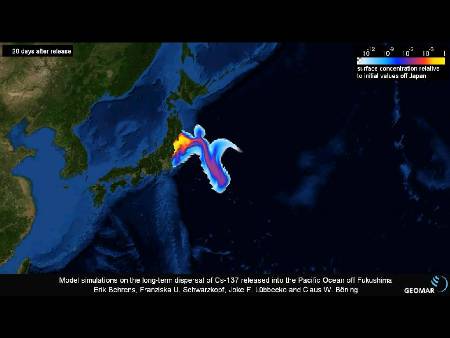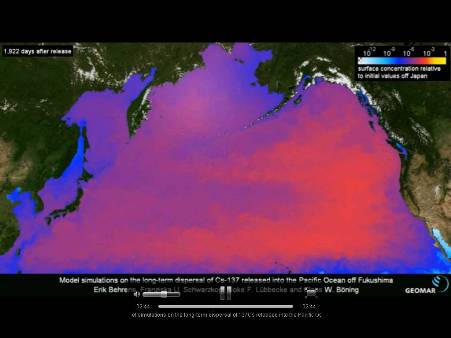福島第一原子力発電所事故後に見られる北太平洋のセシウム134と137
Abstract. Surface seawater 134Cs and 137Cs samples were collected in the central and western North Pacific Ocean during the 1.5 yr after the Fukushima Dai-ichi nuclear power plant accident to monitor dispersion patterns of these radioisotopes towards the Hawaiian Islands.
要約: 福島第一原発の事故から1年半後、ハワイ島に向かう放射性核種の拡散パターンをモニタリングするため、北太平洋の中央と西の海でセシウム134と137を含む水面の海水を収集しました。
In the absence of other recent sources and due to its short half-life only those parts of the Pacific Ocean would have detectable 134Cs that were impacted by Fukushima releases.
半減期が短いため他の汚染源が欠落している中、福島からの漏洩による影響として太平洋で検出できるものはセシウム134です。
Between March and May 2011, 134Cs was not detected around the Hawaiian Islands and Guam. Here, most 137Cs activities (1.2–1.5 Bq m−3) were in the range of expected preexisting levels.
2011年3月から5月の間、セシウム134はハワイ島やグアム島周辺では検出されませんでした。ここでは、ほとんどがセシウム137で、1立法メートルあたり1.2-1.5Bqの範囲が以前から存在していると予測されるレベルでした。
Some samples north of the Hawaiian Islands (1.6–1.8 Bq m−3) were elevated above the 18-month baseline established in surface seawater in Hawaii indicating that those might carry atmospheric fallout.
ハワイ島北のいくつかのサンプルがハワイで18ヶ月の基準線として引かれた1立方メートルあたり1.6-1.8bqを上回りました。
The 18-month time-series analysis of surface seawater from Hawaii did not reveal any seasonal variability or trends, with an average activity of 1.46 ± 0.06 Bq m−3 (Station Aloha, 17 values).
ハワイの海水表面の18ヶ月の期間の分析からは、平均で1立方あたり1.46 ± 0.06bqで、季節による変異性や傾向は見られませんでした。(ステーションアロハ17件-表の青色ひし形点)
In contrast, samples collected between Japan and Hawaii contained 134Cs activities in the range of 1–4 Bq m−3 and 137Cs levels were about 2–3 times above the preexisting activities.
対照的に、日本のハワイ間で収集されたサンプルには、1立方メートル当たり1-4bqのセシウム134と事故前に存在していたセシウム137のレベルの約2-3倍が含まれていました。
We found that the southern boundary of the Kuroshio and Kuroshio extension currents represented a boundary for radiation dispersion with higher activities detected within and north of the major currents.
私たちは、黒潮と黒潮拡張流の南の境界が放射能の拡散の境界を示していることを見出し、その範囲内と主流の北により高い放射能が検出されました。
The radiation plume has not been detected over the past 1.5 yr at the main Hawaiian Islands due to the transport patterns across the Kuroshio and Kuroshio extension currents.
過去1年半、ハワイ島では、黒潮と黒潮拡張流より運ばれるパターンのために放射性プルームが検出されることはありませんでした。
-----------------------------------------------------------------------------
Simulations on the long-term dispersal of 137Cs released into the Pacific Ocean off Fukushima by Helmholtz Centre for Ocean Research
福島事故により放出されたセシウム137のヘルムホルツ海洋研究センターによる拡散シュミレーション
Our study deals with one of the consequences of the disastrous earthquake and subsequent tsunami that hit Japan in March 2011.
わたしたちの研究は、2011年3月に日本を襲った破滅的な地震とそれに続く津波が引き起こした結果の一つを取り扱うものです。
Caused by the explosions and meltdowns in the Fukushima Dai-ichi nuclear power plants, large amounts of radioactive material, including long-living isotopes such as caesium-137, were released into the environment. Contaminated waters entered the Pacific Ocean by atmospheric deposition and direct discharge of coolant in the weeks after the catastrophe.
福島第一原発の爆発とメルトダウンが原因となり、長い間存在し続けるセシウム137のようなものを含む大量の放射性物質が環境に放出されました。大気降下と冷却水の直接排出により、惨事の数週間後に汚染水が太平洋に入り込みました。
In this study we investigate the long-term fate of these waters in the Pacific Ocean, using numerical model experiments. The model simulates the ocean currents with very high resolution; it thus captures much of the intense eddying flows along the Kuroshio.
この研究で私たちは、数値モデル実験を用い、太平洋の海水の長期的な成り行きを調査しています。そのモデルは、非常に高い分析度で、海流をシュミレーションします。このように、黒潮に沿って流れる強烈な渦のほとんどを捉えるのです。
To simulate the dispersal of the contaminated water by the ocean currents, we use an idealized tracer, behaving like a dye with a half live of 30 years, which we injected into the coastal waters off Fukushima. We want to emphasize that our approach is restricted to the physical spreading, and does not account for possible biological effects, for example, adhesion of isotopes to sinking organic matter. Neither does our model assimilate any ocean data, therefore we do not account for the actual state of the local currents at the time of the release. However the initial state turned out to be of minor importance for the tracer spreading after two to three years.
海流による汚染水の拡散をシュミレーションするために、半減期が30年の線量のような振る舞いをする理想的なトレーサーを福島沿岸の海に注入しました。強調したいのは、このアプローチが物質的な拡散に限られていて、可能性のある生物学的な影響、たとえば、底に沈む有機物への核種の付着については説明していません。他のいかなる海洋データとも同化するものではないので、放出された当時のその地域の海流の実際の状況は説明していません。しかしながら、トレーサーが2.3年後に拡散するのに、当初の状況と言うものはあまり重要ではなくなるのです。
The following animation shows the spreading of our dye at the Ocean's surface. The color represents the concentration of the tracer, relative to the initial concentration in the coastal area off Fukushima at the end of the injection period.
次のアニメーションは染料が海水の表面で広がる様子を示しています。色はトレーサーの濃度を表しています。注入期間の最後の福島沿岸地域での最初の濃縮に関連します。
The tracer invades the highly energetic Kuroshio regime within the first weeks after the release and starts spreading meridionaly due to the eddies dominating the flow field in this area.
トレーサーは、放出後第1週の内に、とても活発な黒潮の流れに進入します。その地域で優勢な渦のために南方に拡散し始めます。
After one year, maximum concentrations are diluted by two orders of magnitude and already crossed the dateline, further heading east.
1年後、最大の濃縮が二桁薄められ、日付変更線を超えて更に東へ向かいます。
The southern edge of the tracer cloud reaches the Hawaiian islands after about two years, while the northern edge has begun to enter the Bering Sea.
トレーサーの濁りの南の端は、約2年後にハワイに到着します。一方、北の端は、ベーリング海に入り始めます。
Meanwhile, concentrations near Japan have been dropping significantly due to replacement by less contaminated waters through the Kuroshio, separating the main cloud into a northern and a southern part.
その間、日本付近は、主流の濁りを北と南に分ける黒潮を通して、汚染度の薄い水と入れ替わるため、その濃縮が著しく落ちます。
After four years, the maximum concentration has dropped by three orders of magnitude, and the entire northern Pacific is filled with a certain amount of tracer.
4年後には、最大の濃縮が3桁下落し、北太平洋全体がある一定の量のトレーサーで埋め尽くされます。
When the peak concentration reaches the North American coast after about five to six years, it has been diluted by four orders of magnitude.
約5-6年後に濃縮の頂点が北アメリカ海岸に到達するときには、4桁薄まっています。
The concentration levels from now on tend to homogenize over the entire basin.
これからの濃縮レベルは、流域全体を通して均一になる傾向になります。












No comments:
Post a Comment